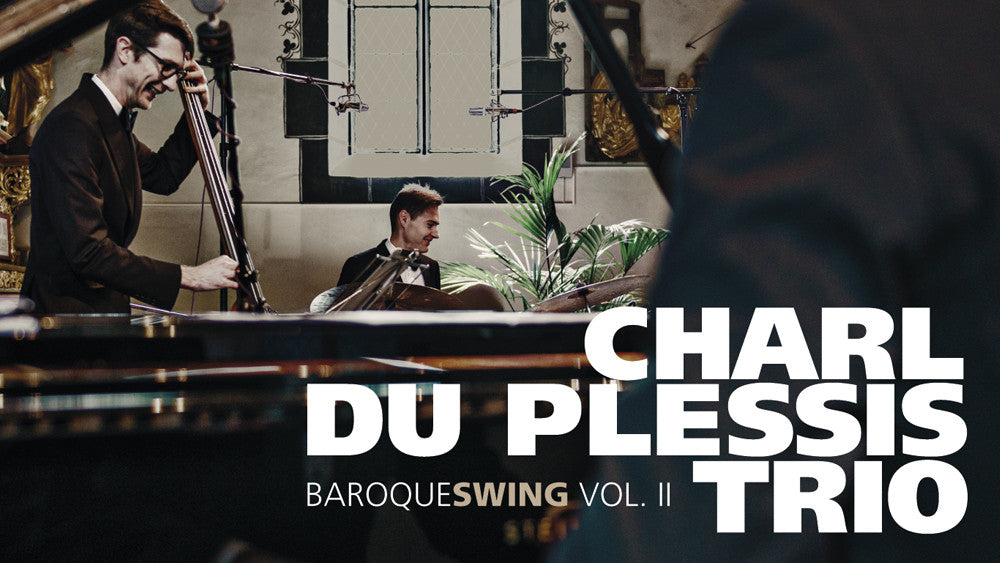
Beeld: baroqueswing Vol. II - review
Here is a review (in Afrikaans) that appeared in BEELD on 26 September 2016 by Paul Boekkooi
Dink aan die Swingle Singers, die Jacques Loussier Trio en die Raymond Guiot-kwintet: Heerlike jazz-improvisasies, soms teen ’n virtuose sneltreintempo wat weliswaar Bach en sy maters hul pruike tydelik laat verloor het, maar uiteindelik ’n stewige brug tussen klassiek en jazz gelê het.
Ons eie Charl du Plessis – ook van nature iewers geneties deel van ’n uiters musikale Franse genepoel – is een van ’n minderheid plaaslike musici met ’n begrip vir barok en die omvattendheid wat so ’n feit impliseer.
Hy en sy trio se jongste CD, getiteld Baroqueswing Vol. II, bewys hoe vryblywend hierdie beweging en sy prosedures, wat byna 50 jaar gelede begin het, uiters avontuurlik toegepas kan bly word.
Dit is verlede jaar in Julie opgeneem voor ’n gehoor in die St. George-kerk in Ernen, Switserland, en verteenwoordig die eerste uitreiking van ’n nuwe platekontrak wat Du Plessis met die bekende Switserse klassieke plate-etiket Claves onderteken het.
Met 19 baroksnitte en ’n 20ste een waar George Gershwin met sy I Got Rhythm om die hoek loer omdat dít die trio se toegif op dié konsert was, kan luisteraars hulle verwonder aan die vryheid wat juis die ou meesters soos Bach, Gluck, Handel en Vivaldi aan Du Plessis en sy twee medespelers, Werner Spies (kontrabas) en Hugo Radyn (tromme), verleen.
Reeds in die openingswerk, die bekende Tokkate en Fuga in d, BWV 565, oorspronklik vir orrel, word dit duidelik dat Du Plessis in sy verwerkings die kontraste tussen veerligtigheid en erns buitengewoon effektief kontrasteer.
Dit gebeur selfs nog sterker in die drie Invensies, onderskeidelik no’s. 8, 4 en 13, waarin die pianis nie noodwendig die notebeeld streng volg nie.
Die eerste een open nogal raaiselagtig, die tweede een taamlik impressionisties en die manier waarop hy hierdie aspekte op die klavier uitlig, is veel boeiender as by sy vroegste verwerkingspogings.
In Gluck se “Mélodie” en die “Ballets des ombres heureuse” uit Orphée et Eurydice is daar weer ryke teenstellings, met laasgenoemde een ’n lighartige swing-verwerking met dryfkrag.
Ewe ongewoon is die trio se weergawe van Vivaldi se “Lentekonsert” uit Die Vier Seisoene.
Frappant is Du Plessis se manier om die solo-viool se klank treffend op die klavier na te boots.
Selfs met meermalige luister word steeds iets nuuts by dié formidabele musici ontdek.
ENGLISH
“Charl du Plessis And Trio Understand Baroque”
Think of the Swingle Singers, Jacques Loussier Trio and Raymond Guiot Quintet: Great jazz improvisations, sometimes at a virtuoso pace, like that of an express train. Although Bach and his companions had to loosen their wigs temporarily, a solid bridge between classic and jazz was eventually built.
Our own Charl du Plessis - also naturally somewhere genetically part of a highly musical French gene pool - is one of a minority South African musicians with an understanding of Baroque and inclusiveness that such a concept implies.
He and his trio's latest CD, entitled Baroqueswing Vol. II proves how vivid this movement and its procedures, which started almost 50 years ago, can still be applied in a most adventurous manner.
It was recorded last year in July in front of an audience in St. George's Church in Ernen, Switzerland, and represents the first issue of a new recording contract Du Plessis has signed with renowned Swiss classic record label Claves.
With 19 tracks of Baroque music and a 20th one where George Gershwin with his I Got Rhythm lurk around the corner (because this is the trio's encore was at this concert). Listeners marvelled at the freedom that the very old masters such as Bach, Gluck, Handel and Vivaldi Du Plessis and his two co-stars, Werner Spies (double bass) and Hugo Radyn (drums), granted.
Already in the opening work, the famous Toccata and Fugue in d, BWV 565, originally for organ, it becomes clear that Du Plessis is able to contrast the lightness and seriousness extremely effective in his arrangements.
This happens even stronger in the three Inventions, respectively Nos. 8, 4 and 13, in which the pianist not necessarily strictly follow the notes image.
The first one starts quite puzzling, the second one quite impressionistic and the way he highlight these aspects on the piano, is much more interesting than with his first attempts at arrangements of this sort.
In Gluck's "Melody" and "Ballets des ombres heureuses” from Orphée et Eurydice there are again rich contrasts, with the latter one is a light-hearted swing arrangement with drive.
Equally unusual is the trio's version of Vivaldi's "Spring Concert" from The Four Seasons.
Du Plessis's way of imitating the solo violin's sound on the piano is remarkable. Even with repeated listening something new can discovered thanks to these formidable musicians.
BAROQUESWING VOL. II - Charl du Plessis Trio. Music of JS Bach, Gluck, Vivaldi, Handel and Gershwin. Charl du Plessis (piano and arrangements), Werner Spies (double bass) and Hugo Radyn (drums). Claves CD 50-1609.
Article's source: http://www.netwerk24.com, by 26 September 2016
Find this album on Claves.ch
Related collections
Antonio Vivaldi
Charl du Plessis Trio
Double bass
Folk, popular & jazz
Georg Friedrich Händel
Johann Sebastian Bach
New releases
Piano
Popular products
Releases 2015 - 2017
Preorder it online
iTunes
GooglePlay
AmazonMp3
Qobuz


Commentaires
0 Commentaires